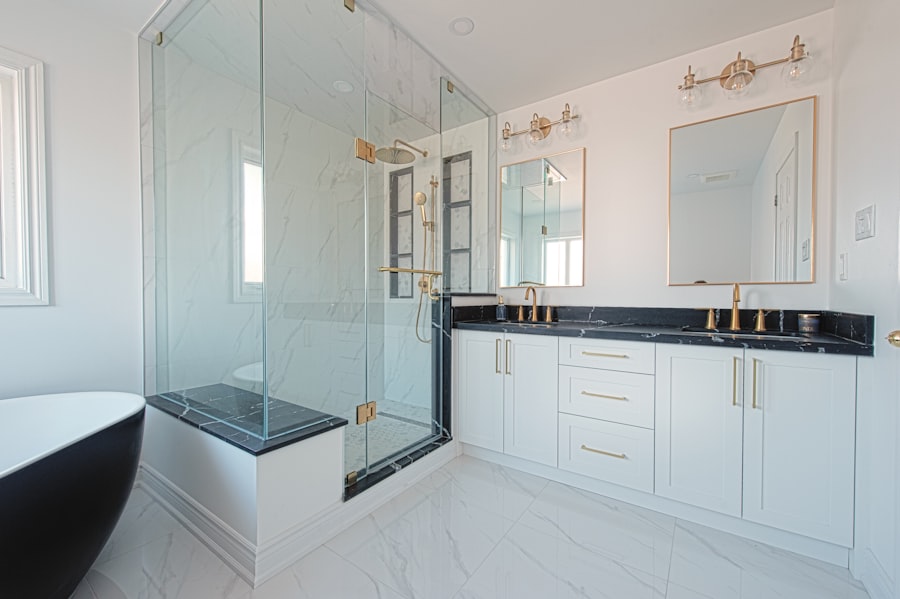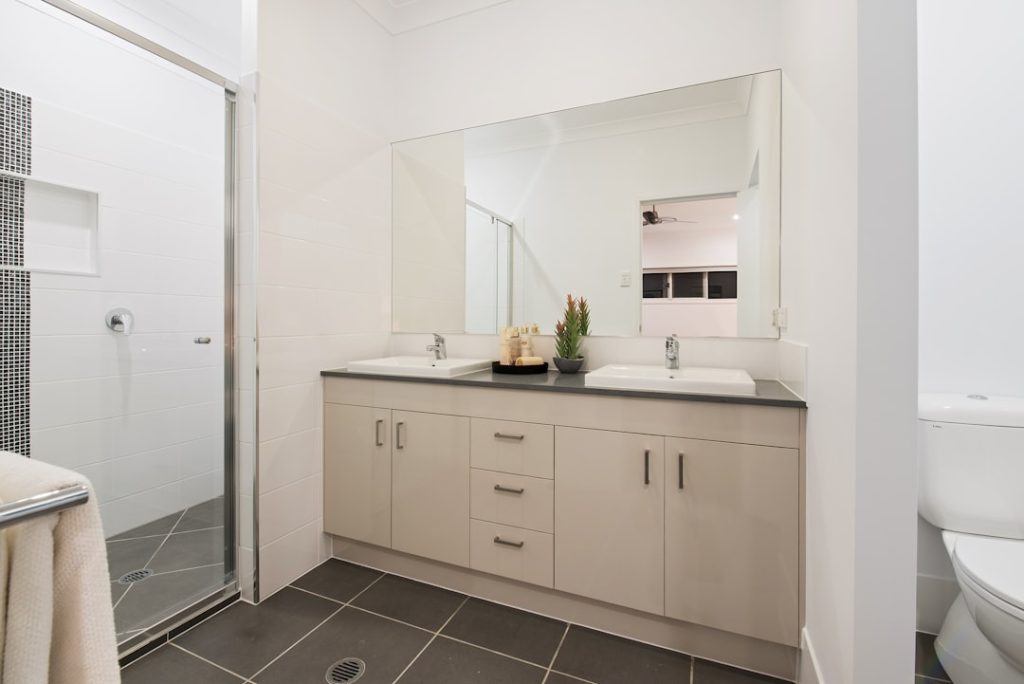A custom bath vanity serves as more than just a functional piece of furniture; it is a focal point that can elevate the overall aesthetic of a bathroom. One of the primary benefits of opting for a custom design is the ability to tailor the vanity to fit specific dimensions and layouts. Standard vanities often come in fixed sizes that may not align with the unique measurements of your space, leading to awkward gaps or inefficient use of available area.
A custom vanity allows homeowners to maximize their bathroom’s potential, ensuring that every inch is utilized effectively. This is particularly advantageous in smaller bathrooms where space is at a premium, as a custom solution can incorporate clever design elements that enhance both functionality and style. Moreover, a custom bath vanity offers the opportunity to select materials, finishes, and styles that resonate with personal taste and the overall theme of the home.
Unlike mass-produced options, which may lack character or uniqueness, a custom vanity can be crafted to reflect individual preferences, whether that be a modern minimalist look or a more traditional, ornate design. This level of personalization not only enhances the visual appeal of the bathroom but also contributes to a sense of ownership and pride in one’s living space. Additionally, custom vanities can be designed with specific features in mind, such as integrated lighting or specialized storage solutions, further enhancing their utility and charm.
Key Takeaways
- Custom bath vanities offer tailored design and enhanced functionality for your bathroom space.
- Selecting durable and suitable materials is crucial for longevity and style.
- Incorporate smart storage solutions to maximize space and organization.
- Personalized design elements can reflect your unique taste and complement your bathroom decor.
- Professional installation ensures proper fitting and helps maintain the vanity’s quality over time.
Choosing the Right Materials for Your Custom Bath Vanity
Selecting the right materials for a custom bath vanity is crucial, as it impacts both the durability and aesthetic appeal of the piece. Common materials include solid wood, plywood, and engineered materials like MDF (medium-density fiberboard). Solid wood is often favored for its natural beauty and strength; however, it can be susceptible to moisture damage if not properly sealed.
Plywood offers a more stable alternative that resists warping and is less prone to damage from humidity, making it an excellent choice for bathroom environments. Engineered materials like MDF are cost-effective and can be finished in various ways to mimic the appearance of wood while providing resistance to moisture. In addition to the structural materials, the choice of finishes plays a significant role in the overall look and longevity of the vanity.
For instance, water-resistant paints or stains can protect wood surfaces from the inevitable splashes and spills that occur in bathrooms. Furthermore, hardware choices such as knobs and pulls should complement the material and finish of the vanity. Opting for high-quality metal finishes can enhance durability while adding a touch of elegance.
The combination of these materials and finishes not only contributes to the vanity’s functionality but also ensures that it remains visually appealing over time.
Designing a Custom Bath Vanity to Fit Your Space

When designing a custom bath vanity, it is essential to consider the specific dimensions and layout of your bathroom. Accurate measurements are critical; they inform decisions about height, width, and depth, ensuring that the vanity fits seamlessly into the space without overwhelming it. For instance, in a compact bathroom, a floating vanity can create an illusion of more space by allowing visibility beneath it.
Conversely, in larger bathrooms, a double-sink vanity may be appropriate to accommodate multiple users while providing ample counter space. The design process should also take into account the overall style of the bathroom. A contemporary space may benefit from sleek lines and minimalist features, while a more traditional setting might call for intricate detailing and classic finishes.
Additionally, considering the placement of plumbing fixtures is vital; aligning sink locations with existing plumbing can save on installation costs and simplify the design process. Ultimately, a well-thought-out design will harmonize with the rest of the bathroom while fulfilling practical needs.
Incorporating Storage Solutions into Your Custom Bath Vanity
| Storage Solution | Average Storage Capacity | Space Utilization Efficiency | Common Materials | Estimated Installation Time | Maintenance Level |
|---|---|---|---|---|---|
| Drawers | 15-25 liters per drawer | High (80-90%) | Wood, MDF, Plywood | 4-6 hours | Low |
| Open Shelves | 20-30 liters per shelf | Medium (60-70%) | Wood, Metal, Glass | 3-5 hours | Medium |
| Cabinet Doors with Internal Shelves | 30-50 liters per cabinet | High (85-95%) | Wood, MDF, Laminate | 5-7 hours | Low |
| Pull-out Trays | 10-15 liters per tray | High (90-95%) | Metal, Wood | 4-6 hours | Medium |
| Built-in Hampers | 40-60 liters | Medium (70-80%) | Wood, Plastic | 6-8 hours | Medium |
Storage is often one of the most significant challenges in bathroom design, making it essential to incorporate effective solutions into your custom bath vanity. A well-designed vanity can provide ample storage for toiletries, towels, and other essentials while maintaining an organized appearance. One popular approach is to include drawers of varying sizes; shallow drawers can be perfect for makeup and smaller items, while deeper drawers can accommodate larger items like hairdryers or extra towels.
In addition to drawers, open shelving can be an attractive way to display decorative items or frequently used products. This approach not only adds visual interest but also encourages easy access to essentials. For those who prefer a more streamlined look, consider incorporating hidden compartments or pull-out trays that keep items out of sight while still being easily accessible.
By thoughtfully integrating storage solutions into your custom bath vanity design, you can create a functional space that minimizes clutter and enhances overall efficiency.
Selecting the Perfect Countertop for Your Custom Bath Vanity
The countertop is one of the most visible elements of a custom bath vanity and plays a significant role in both functionality and aesthetics. When selecting a countertop material, consider factors such as durability, maintenance requirements, and style compatibility with the rest of your bathroom decor. Popular choices include natural stone options like granite or marble, which offer timeless beauty but require regular sealing to prevent staining.
Quartz countertops are another excellent option; they are non-porous and resistant to scratches and stains while available in an array of colors and patterns. In addition to material considerations, the thickness and edge profile of the countertop can dramatically influence its appearance. A thicker countertop can convey a sense of luxury and solidity, while a thinner profile may lend a more modern feel.
Edge profiles range from simple straight cuts to more elaborate designs like ogee or bullnose edges, each contributing its own character to the overall look of the vanity. Ultimately, selecting the perfect countertop involves balancing aesthetic preferences with practical considerations to ensure that it meets both style and functional needs.
Adding Personalized Touches to Your Custom Bath Vanity

Personalization is what truly sets a custom bath vanity apart from off-the-shelf options. Adding unique touches can transform an ordinary piece into something that reflects your personality and style. Consider incorporating decorative elements such as custom cabinetry details or unique hardware that aligns with your vision for the space.
For example, vintage-style knobs or pulls can add charm to a traditional vanity, while sleek metal finishes may enhance a contemporary design. Another way to personalize your vanity is through color selection. While neutral tones are popular for their versatility, bold colors can make a striking statement and serve as an eye-catching focal point in your bathroom.
Additionally, integrating personal artwork or decorative items on open shelves can further enhance individuality. These thoughtful details not only make your custom bath vanity uniquely yours but also create an inviting atmosphere that resonates with your personal style.
Working with a Professional to Install Your Custom Bath Vanity
While designing and selecting materials for your custom bath vanity can be an exciting process, working with a professional for installation is crucial for achieving optimal results. Experienced contractors or carpenters possess the skills necessary to ensure that your vanity is installed correctly and securely. They can navigate potential challenges such as plumbing adjustments or structural considerations that may arise during installation.
Moreover, professionals can provide valuable insights during installation regarding best practices for maintaining alignment and ensuring proper sealing around sinks and countertops. This attention to detail not only enhances functionality but also contributes to the longevity of your investment. Collaborating with experts ensures that your vision is realized accurately while adhering to safety standards and building codes.
Maintaining and Caring for Your Custom Bath Vanity
Once your custom bath vanity is installed, ongoing maintenance is essential to preserve its beauty and functionality over time. Regular cleaning with appropriate products is vital; harsh chemicals can damage finishes or surfaces, so it’s best to use gentle cleaners specifically designed for the materials used in your vanity. For instance, natural stone countertops require pH-balanced cleaners that won’t etch or dull their surface.
Additionally, periodic inspections for signs of wear or damage are important for maintaining your vanity’s integrity. Check for loose hardware or any signs of water damage around sinks or plumbing fixtures. Addressing these issues promptly can prevent more significant problems down the line.
By implementing these maintenance practices, you can ensure that your custom bath vanity remains a stunning centerpiece in your bathroom for years to come.



